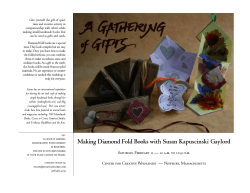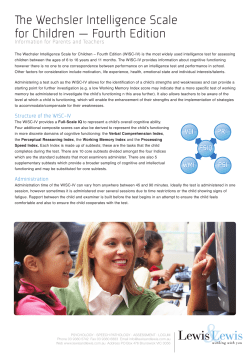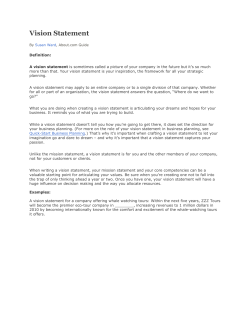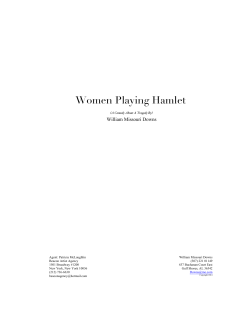
Document 232107
ESTUDIO DE VALIDEZ DISCRIMINANTE Y ANÁLISIS DE DIFICULTAD DE LOS REACTIVOS DE LA WECHSLER INTELLIGENCE SCALE FOR CHILDREN-FOURTH EDITION, SPANISH EN UNA MUESTRA DE ESTUDIANTES DE 10.0 A 11.11 AÑOS DE EDAD CRONOLÓGICA EN ESCUELAS PÚBLICAS Y PRIVADAS EN EL ÁREA SUR DE PUERTO RICO Nombre:_____________________________________________ Fecha:_____________________________ How to score the WISC-IV: Test Yourself1 Circle the best option. 1. On a Similarities subtest item, Jessica, age 7, provides several responses that vary greatly in quality, but do not spoil her response. You should:2 a. score Jessica’s best response. b. score the last response given by Jessica. c. score the first response given by Jessica. d. query Jessica for further information. 2. If a child obtains total raw scores of 0 on two of the three subtests that compose the Verbal Comprehension scale, including potential substitutes, no VCI or FSIQ can be derived. a. True b. False 3. Susan, age 12, attempts to self-correct an item on the Coding subtest. You should: a. score the last response given by Susan within the time limit. b. score Susan’s first response, ignoring her self-correction attempt. c. query Susan as to which response is her intended response. d. score Susan’s best response. 4. A poor response is an elaboration that does not improve the child’s spontaneous response, whereas a spoiled response is an elaboration that reveals a fundamental misconception about the item. a. True b. False 5. If an examiner administered additional items to a child beyond the point at which testing should have discontinued, the examiner should: a. include all additional items in the total raw score. b. include the additional items in the total raw score only if they are correctly answered. c. award no points for items beyond the correct discontinue point. d. include the additional items in the total raw score by deducting points for incorrect responses committed after the discontinue point. 6. Samuel, age 10, is suspected to be intellectually deficient. Hence, you administer him items prior to his age-appropriate start point. Samuel answered these items incorrectly, but obtained perfect scores on his age-appropriate start point and subsequent item. In this case, you should: a. Consider the subtest spoiled and do not calculate a raw score. b. Include the incorrect responses in the calculation of the total raw score. c. Award partial credit (i.e. ____ point) for each incorrect item that precedes the ageappropriate start point. d. Award full credit for all items preceding the age-appropriate start point. 7. Information should be included in the calculation of which WISC-IV index: a. VCI b. PRI c. PSI d. WMI e. None of the above, unless it is used to substitute for another test contributing to the VCI. 8. When scoring the Symbol Search subtest, you notice that Angela, age 9, skipped some items. You should count the items that she skipped in the incorrect total. a. True b. False Source: Flanagan, D. P., Kaufman, A. S. (2004). Essentials of WISC-IV Assessment. New Jersey: Wiley. 1 2 1:a; 2:a; 3:a; 4:a; 5:c;6:d; 7:e; 8:b Si el niño provee múltiples respuestas espontáneamente de diferentes valores (1 pt. y 2pts.) a un reactivo y se autocorrige luego de su primera respuesta incorrecta, puntúe solo la respuesta intencionada. Si no está claro cuál es la respuesta intencionada, diga: “Dijiste____ y dijiste ____. ¿Cuál quieres decir?” Puntúe la respuesta intencionada. Sólo si el niño ofrece una respuesta de 2pts primero y luego de 1pt., discrimine si la intención fue para aclarar la respuesta y puntúe la de mayor valor. pp. 35-36 Manual WISC-IV Spanish
© Copyright 2025





















